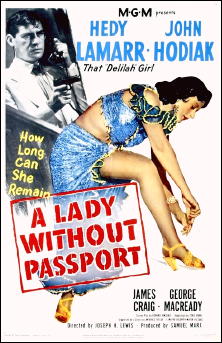May 2011
Monthly Archive
Wed 25 May 2011
I’ve had less time than usual to spend here at the computer the past couple of weeks, so it’s taken me longer than normal to get Part 41 of the online Addenda to the Revised Crime Fiction IV posted. Al Hubin sent it to me late last week, and it’s ready for viewing at last — corrected, amended and updated as of yesterday evening. (Follow the links.)
As it happens now every three months or so, like clockwork, there are the usual additions: newly discovered series characters and settings for the novels, a few new authors and novels, dates of birth and death added or corrected. Loads and loads of facts and additional information about our favorite hobby: reading and collecting detective and mystery fiction, with a small portion of it, I’m happy to say, generated by the reviews and other discussions that take place on this blog.
Wed 25 May 2011
THE BACKWARD REVIEWER
William F. Deeck
VIOLA BROTHERS SHORE – The Beauty-Mask Murder. Richard R. Smith, US, hardcover, 1930, 384 pages. UK: John Hamilton, hc, 1932, as The Beauty-Mask Mystery.
Luckily for the innocent suspects in this case, Gwynn Leith is in Hanaford visiting her brother, His Honor the Mayor. If it had been left to the mayor and the police, a whole series of suspicious characters would have been arrested for the multiple murder — by an overdose of morphine; poison, and throat slitting — of an extremely unpleasant woman who was also most unattractive at the time of her death.
A widow of uncertain age, Leith is a most intelligent woman with a low opinion of the male mentality. She is, as it were, an early feminist. Her involvement in the case keeps the innocent from being prosecuted by official stupidity. As she says:
“The trouble with you men is that you would rather have an innocent victim than nobody at all. Just so the poor chap looks guilty enough to cover any obvious stupidity. That’s why I think women would be a great improvement on the force. Their quick sympathies would keep them from leaping at conclusions just to gratify their vanity and their insatiable craving for results.”
Where Hanaford is located, I don’t know. A little research should find it, for it’s in a state in which the Grand Jury determines guilt or innocence. There can’t be many of those.
— From The MYSTERY FANcier, Vol. 12, No. 3, Summer 1990.
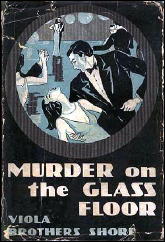
Bio-Bibliographic Notes: Included in the Revised Crime Fiction IV, by Allen J. Hubin, is one other book by Viola Brothers Shore: Murder on the Glass Floor (Long & Smith, 1932). The most interesting Gwynn Leith is a character in it also, but so is someone called Colin Keats, a fellow whose appearance in The Beauty-Mask Murder Bill Deeck did not happen to mention.
An online website devoted to Jewish authors has a page with a long biography of the author, Viola Brothers Shore (1890-1970), from which I excerpt the following:
“While attending New York University, Viola Brothers Shore began her career as a writer in a range of disciplines. She wrote poetry, biography […], stories and articles published in
College Humor,
Collier’s, and
Saturday Evening Post; [and] plays […] Her short stories, many about Jewish American lives of the day, were collected in
The Heritage and Other Stories (1921).
“Shore wrote silent movie titles and original stories for many motion pictures including The Kibitzer (1929) and Walking on Air (1936). […] She wrote numerous mystery stories, including The Beauty Mask Murder (1930) and Murder on the Glass Floor (1932) and won several Ellery Queen awards.”
Tue 24 May 2011
A LADY WITHOUT PASSPORT. MGM, 1950. Hedy Lamarr, John Hodiak, James Craig, George Macready, Steven Geray, Bruce Cowling, Nedrick Young, Steven Hill, Richard Crane. Director: Joseph H. Lewis.

This is one of those black and white semi-documentary movies about one of the various US law enforcement services that were common in the late 1940s and early 50s, in this case the Immigration Service.
While the story value is rather low, if you were to ask me, that the director was Joseph H. Lewis means that there’s lots of entertainment value to be found in the staging, the lighting, the settings, the camera angles – everything that a director can do to make a dull thud of a movie interesting, Joseph Lewis (no relation) does.
John Hodiak is sent to Havana to get the goods on a sophisticated operation of smuggling illegal immigrants into the US through that port of entry, and in particular mastermind George Macready, who plays his part to the hilt. No one can act in as slick, sinister and evil a fashion as he!

The would-be immigrants are mostly refugees from war-torn Europe or criminals of various persuasions, and among them is Hedy Lamarr, as radiantly beautiful as she always was as a former prisoner of Nazi concentration camp.
John Hodiak falls in love with her, of course, as who wouldn’t, and is even willing to give up his job for her, in light of the obviously untenable situation they find themselves in.
The problem is, from the viewer’s point of view, is that Miss Lamarr is far too beautiful, with far too many fashionable clothes, to ever be accepted as a refugee from the Nazis with no legal place to escape to. Accept her at face value, for the sake of the story, or not at all. While I don’t know about you, I went with the first choice, but full honesty in reviewing, according to my Guild notes, requires me to point this particular dilemma out to you.
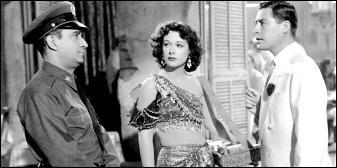
Havana makes a nice place to film a movie – many shots are on location – but speaking of unusual camera angles, as I was earlier, two scenes are most worthy of note:
First, an confrontation on a busy Manhattan street at the beginning of the film, one that ends in the death of one of the participants, is filmed from inside an automobile, looking outward through the windows as the camera tracks the action; a second one, looking straight down from above as the passengers like ants make their way out of a downed plane in the Everglades and form themselves into groups, is a scene I’ve never seen from this particular perspective before.
Mon 23 May 2011
REVIEWED BY STAN BURNS:
MIDSOMER MURDERS. BBC-TV; two from Season 11. John Nettles (DCI Tom Barnaby, Jason Hughes (DS Ben Jones), Jane Wymark (Joyce Barnaby), Barry Jackson (Dr Bullard). Based on the characters created by Caroline Graham.
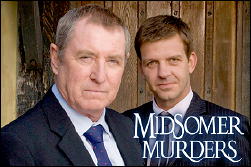
In “Left for Dead” (24 May 2008), Detective Chief Inspector Barnaby investigates the death of a couple in an isolated house.
They had totally cut themselves off from the surrounding community — no one had been invited into the house in years, and there was no electricity or running water. The woman appears to have died of natural causes, but the man seems to have been pushed down the stairs.
Barnaby’s investigation becomes intertwined with a protest movement against highway construction, and the disappearance of a child 19 years before. This is the best one of these I have seen in awhile — harking back to the earlier movies in this series (these are too complex and well produced to be called episodes). It also reminded me a little of Jack Vance’s Bad Ronald.
In the earlier “Shot at Dawn” (1 January 2008), a feud between two families going back to WWI results in the murder of the elder statesman of one of the families. But when Barnaby investigates he finds that the feud may not have been the cause of the murder — instead it may be the result of a disputed piece of land that can be developed into homes for a fortune.
One of the better of the more recent ones, but the murderer is obvious. Still there are a lot of twists and turns getting to the end. If you don’t mind that the characters are more than a bit eccentric, I suspect you will like both of these.
Rating: B minus (both).
Mon 23 May 2011
REVIEWED BY GEOFF BRADLEY:
IDENTITY. “Second Life.” 28 April 2010. (Season 1, Episode 1.) ITV [UK]. Aidan Gillen, Keeley Hawes, Holly Aird, Elyes Gabel, Shaun Parkes, John Hopkins, Patrick Baladi. Creator/writer: Ed Whitmore. Director: Brendan Maher.

This was a six part series (one hour each, less adverts) based in a unit set up to combat identity theft. Detective Superintendent Martha Lawson (played by Keeley Hawes, fresh from Ashes to Ashes) is in charge and her leading detective, newly returned from a 15-year (yes, 15 year) undercover assignment is D.I. John Bloom (played by Aidan Gillen, fresh from The Wire, but here regaining his Irish accent). Bloom is quiet moody and enigmatic, but his contributions are, of course, the most telling.
The series, though, is clearly going for big time transgressions. This first episode starts with a man who has shot a policeman from his bedroom window when they have been sent to arrest him after the car he had leased is used to kill a woman. He is, he pleads, after being shot by a police marksman, the victim of identity theft.
Soon the unit has three linked cases, all involving murder, with an innocent man being gaoled. However, Bloom decides, the culprit is deliberately revealing his actions. But why?
Like a lot of current programmes, this held the interest with a complex and intriguing story. Unfortunately the denouement, which I won’t go into, did little to sort out how it had all been achieved. Of course the perpetrator was a computer geek, but we have to take as read how he could have achieved his nefarious objectives and managed to maintain the lifestyle he had.
Entertaining but don’t expect it to make sense.
Sun 22 May 2011
THE SAINT IN JUNIOR HIGH
by Ron Goulart
I was fourteen when I wrote to Leslie Charteris asking him to allow me to adapt The Saint for the theater. The theater in question being the auditorium of Burbank Junior High School in Berkeley, California.

Although the Saint I’d seen on the screen in the RKO B-Movies of a few years earlier was portrayed by the suave George Sanders, who was well over six feet tall, I had no doubt that I, who’d recently shot up to the impressive height of five foot four, could do a nifty job of portraying Simon Templar. I was equally certain that I could summon up sufficient suaveness.
I’d discovered the Saint, that Robin Hood of Modern Crime, by way of the movies, but the advent of Pocket Books allowed me, for just two bits each, to get hold of most of novels and short story collections that had appeared since Charteris had created the character back in 1928.
I liked not only the thriller aspects, and the mystery and crime elements but the humor in the books (which seems to have partially leaked out the last time I attempted to reread one). Charteris has said in the introduction to one of his books that one of his major influences was P. G. Wodehouse, another of my literary idols back in the days when I was starting to shave.
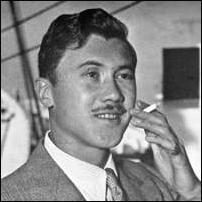
In that bygone era my contact with the entertainment world — books, radio, movies, comic books, etc. — was strictly as a consumer. I therefore assumed that it would be relatively simple when I was a few years older to become a novelist, a short story writer, a movie star, a radio actor, a playwright and a matinee idol, a cartoonist who drew gag cartoons, a syndicated comic strip and a comic book of his own.
In junior high I was a sort of economy-size Orson Welles. I wrote play adaptations of Robin Hood, A Connecticut Yankee and A Christmas Carol and starred in each one. Seeing me, in green tights, cross swords with the Sheriff of Nottingham is probably one of the memories most of my fellow students have had a difficult time forgetting.
I exchanged a few more letters with Charteris. I believe the first one was written when he was affiliated with his own paperback publishing company in Los Angeles. They were reissuing quite a few Saint books, plus new anthologies with stories about Hollywood, etc.
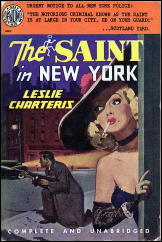
There was also one collecting radio scripts from various shows, including one from a Saint broadcast. I suggested to him that a whole book of Saint scripts would be a good idea. He responded that since the scripts were mostly adaptations of printed stories that probably wouldn’t attract a large enough audience.
Quite a few years later, when I was editing The British Detective anthology for Signet, I thought it would be a good idea to include a Saint novelet, “The Million Pound Day.”
Charteris replied that since his story was twice as long as most of the others, he should receive twice the offered fee of $500. So I missed a chance to be Leslie Charteris’s editor.
When I was working on a Nostalgia Book Club book about radio detectives, I queried him as to who he thought the best actor to play his character on radio. He was residing on the Riviera at the time, possibly in a yacht. His fourth wife was the movie actress Audrey Long, frequently seen in the RKO B- Movies of the 1940s.
He sent a helpful reply and mentioned that if I wrote him again I include return postage. The nostalgia line went out of business before I ever wrote the book.
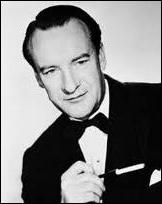
Several men assayed the role of Simon Templar on the air. The show ran, off and on, from about 1945 to 1950. They included Edgar Barrier, Brian Aherne, Vincent Price (when I listened to him back then I didn’t notice what a smarmy Saint he made) and Tom Conway. The Saint’s creator told me the best man was the first one, Edgar Barrier.
I noticed on Google that Charteris said the movie actors he thought should have been Templar were Ronald Colman, Cary Grant or Douglas Fairbanks, Jr. As for the actual chaps who played the part, he said “Louis Hayward and George Sanders were hopelessly miscast.”
Raymond Chandler, by the way, said he thought the ideal actor to play Philip Marlowe was Cary Grant. You can’t beat suaveness.
Ron Goulart

Mr. Ronald Goulart
1343 Kains Ave
Berkeley 2, Calif
Dear Mr Goulart:
I’m sorry I can’t give you permission to any dramatic
adaptations on the Saint. It isn’t a matter of the royalty
in the case of a non-profit production, but the fact that I
can’t allow my character to be handled by anyone without
my supervision, and if I were to give my supervision, I’m
afraid I couldn’t be persuaded to do so for no profit.
So I’m afraid you’ll just have to find some other subject
to exercise your talents on.
Thanks just the same for your interest in this and other
Saint matters.
Cordially,
[Signed]
Leslie Charteris
LC:PW
Previously on this blog:
LESLIE CHARTERIS – The Brighter Buccaneer (reviewed by Art Scott)
LESLIE CHARTERIS – The Saint in New York (reviewed by Art Scott)
LESLIE CHARTERIS – The Saint and the Templar Treasure (reviewed by Steve Lewis)
Sun 22 May 2011
Posted by Steve under
Reviews[4] Comments
LESLIE CHARTERIS – The Saint and the Templar Treasure. Doubleday Crime Club, hardcover, 1979. UK edition: Hodder & Stoughton, hardcover, 1979. Developed by Graham Weaver from comic strips by Donne Avenelle.
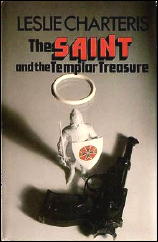
It isn’t any secret, but let’s give credit where credit is due. Few if any of the adventures of Simon Templar that have appeared in recent years have actually been written by Leslie Charteris. The title page says this one was the collaborative effort of Donne Avenell and Graham Weaver [see above] but (as I understand it) under Charteris’s close, keen-eyed supervision.
The countryside in Treasure is authentically French, and the year is 1945, without a doubt a vintage one for Saintly activities. And just one sip will tell you that the flavor is unmistakably the heady one of Simon Templar’s younger days, filled to the brim with the sheer intoxicating joy of partaking in carefree adventure.
A vineyard is in trouble. It could hardly be coincidence that the chateau is also possessed of a curse handed down since the days of our hero’s Templar forebears, and take a hand in it he must.
Make no mistake about it, this is no whodunit in the traditional sense. Even if there were no word as “insouciant” to describe the Saint’s approach to detective work, the overwhelming need for its invention requires no further evidence than this.
— Reprinted from The MYSTERY FANcier, Vol. 3, No. 6, Nov/Dec 1979 (slightly revised).
Sun 22 May 2011
A 1001 MIDNIGHTS Review
by Art Scott
LESLIE CHARTERIS – The Saint in New York. Doubleday Crime Club, hardcover, 1935. First published in the UK:Hodder & Stoughton, hardcover, 1935. Reprinted many times since, in both hardcover and paperback. Film: RKO, 1938 (with Louis Hayward as Simon Templar, and Jonathan Hale as Inspector Fernack).
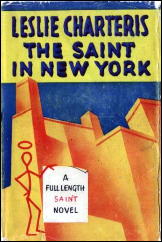
This novel is perhaps the best of the tales in which Simon Templar adopts the role of Nemesis, dispensing summary justice to criminals. It is one of the grimmest tales in the Saint saga; it is a furiously paced, tightly crafted, wholly satisfactory blood-and-thunder thriller.
Wealthy William Valcross offers the Saint $1 million to avenge the death of his son, who was murdered by a kidnap mob terrorizing New York. The Saint accepts the job, makes up a list of six big-time mobsters to be killed, and announces his intention to clean up the city to the newspapers.
In three days of furious action, he makes good on his promise. Along the way he adds another name to his list, the mysterious “Big Fellow,” a Moriartyesque mastermind who pulls the strings behind the scenes; and encounters a woman of mystery, Fay Edwards, who saves his life when he’s taken for a ride.
He also forms an uneasy alliance with John Henry Fernack, chief of New York detectives, who thereafter became a continuing character, reappearing whenever Templar’s travels take him to the States.
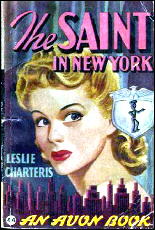
The episode in which Templar, armed with only a knife and his wits, takes on a houseful of mobsters in order to save a kidnapped girl is as neatly choreographed and exciting an action sequence as is to be found anywhere in Charteris’s work. The book concludes with a dramatic surprise ending, in which the Saint learns the identity of the Big Fellow.
The Saint in New York predates by some forty years a paperback landslide of similar one-man-against-the-mob novels written by Don Pendleton and his many imitators. It is unlikely that any have yet equaled this book for excitement; certainly none has come close in style.
Other Saint books of note: Getaway (1932), The Misfortunes of Mr. Teal (1934) (ss), Saint Overboard (1936), The Happy Highwayman (1939) (ss), and The Saint in Miami (1940).
———
Reprinted with permission from 1001 Midnights, edited by Bill Pronzini & Marcia Muller and published by The Battered Silicon Dispatch Box, 2007. Copyright © 1986, 2007 by the Pronzini-Muller Family Trust.
Sun 22 May 2011
A 1001 MIDNIGHTS Review
by Art Scott
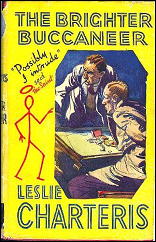
LESLIE CHARTERIS – The Brighter Buccaneer. Doubleday Crime Club, hardcover, 1933. First published in the UK: Hodder & Stoughton, 1933. Reprinted many times, often [warning] with some stories not included.
Leslie Charteris’s long-lived and internationally popular character, the Saint, has appeared in two widely different sorts of tales. In the novels, he is the piratical adventurer and self-appointed executioner, usually involved in melodramatic thrillers with lots of action and political intrigue. The Saint short stories, however, tend to be more jocular and subdued, and often have elements of genuine detection.
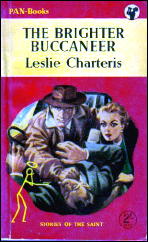
Charteris has made one particular sort of short story his specialty — the “sting” story, in which Simon Templar outcons the con men. In doing so, he makes good the losses of the previously fleeced-in line with his reputation as “the Robin Hood of Modern Crime” — and pockets a nice profit for himself in the bargain.
Several of the stories in this collection are classics in this genre. In “The Brain Workers,” for instance, Templar adopts his favorite disguise as twittish Sebastian Tombs to outwit one Julian Lamantia, dealer in phony oil stock; in the final story, “The Unusual Ending,” Lamantia comes in for another dose of the same (this time he’s running a Ponzi scheme). “The Unblemished Bootlegger,” a tale of poetic retribution, is noteworthy in that it marks the debut of Peter Quentin, who became one of the Saint’s regular accomplices in later stories.
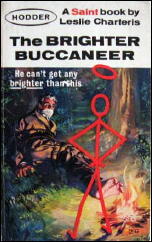
“The Appalling Politician” provides a break from the con games. It is a detective story, in which the Saint’s long-suffering adversary, Chief Inspector Claude Eustace Teal, calls on Templar to help out with a stolen-treaty problem. In this one, as he often does, Charteris makes use of his fictional alter ego to get off a few witty blasts at pompous British politicians.
The best of all the stories is “The Green Goods Man,” in which Templar neatly turns the tables on a counterfeit-money scam artist. It has two truly memorable scenes and a slick double-twist ending.
———
Reprinted with permission from 1001 Midnights, edited by Bill Pronzini & Marcia Muller and published by The Battered Silicon Dispatch Box, 2007. Copyright © 1986, 2007 by the Pronzini-Muller Family Trust.
Sun 22 May 2011
REVIEWED BY MICHAEL SHONK:
THE AMAZING MR. MALONE. Based on character created by Craig Rice. Written by Gene Wang; produced by Bernard L. Schubert.
â— ABC: January 11, 1947 through March 26, 1949. Frank Lovejoy as John J. Malone.
â— ABC: September 21, 1949 through September 24, 1950. Gene Raymond as John J. Malone.
â— NBC: May 25, 1951 through July 13, 1951. George Petrie as John J. Malone.
With the success of Craig Rice’s books and the films based on her character John J. Malone, radio wanted its turn with the popular Chicago lawyer. The ratings were good but the loss of sponsor Guild Wine forced ABC to drop its first attempt at a series, starring Frank Lovejoy. Despite two later tries, The Amazing Mr. Malone never got the sponsor it needed to survive.
Originally titled Murder & Mr. Malone, the series was an uneven attempt to blend humor, screwball plots and hardboiled mystery together. However, there were just enough moments where it worked to make The Amazing Mr. Malone one of the best comedy mystery series radio produced.
Not making the transition from the books were the characters of Jake Justus and Helene Brand Justus. Rice’s cop, Lt. Daniel Von Flanagan and his “woe is me” humor was first replaced by typical banter between Malone and Lt. McGraw, then with Lt. Sidney Brooks. Maggie, Malone’s secretary, was rarely mentioned.
Each show began with the sound of two gunshots. A frantic voice at a telephone pleading, “Operator, operator, get me John J. Malone!”
When the series was called Murder & Mr. Malone the announcer would introduce Malone as “fiction’s most famous criminal lawyer.” After the title changed to The Amazing Mr. Malone, the introduction became more sarcastic with “whose practice before every type of bar has become legend.” Malone then introduced the story, and after he became “amazing,” added the cliche of the week that illustrated the episode’s “moral” which was also its title.
The story would often begin without Malone until deep into the episode. The epilogue would usually feature Malone and Brooks at a bar discussing the case. During the Petrie series, the fourth wall would be ignored during the epilogue scene.
The following are reviews of all known (by me) surviving complete episodes of the series:
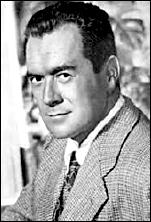
â— FRANK LOVEJOY. Recorded in Hollywood. Cast: not credited (except Lovejoy, of course).
“Charles Morgan” (May 24, 1947) In the opening of this episode from the Murder & Mr. Malone period, Malone admits he has no sense of humor and he wasn’t kidding. The serious hardboiled tone was more Black Mask than Craig Rice.
Practical joke playing gambler hires Malone to prove he didn’t kill a man who owed him money. Malone finds himself faced with a locked room mystery.
“Cleanliness is Next to Godliness” (August 28, 1948) The series is now called The Amazing Mr. Malone, and this episode reflects an effort to recreate Rice’s screwball plots. Lovejoy’s lack of comedic ability cripples any attempts of humor by Malone.
Nightclub owner murders a politician and frames his rival with the rival’s lucky rabbit’s foot.
â— GENE RAYMOND. Recorded in Hollywood. Cast: Lt. Brooks: Henry Morgan. Guest Cast not credited but included Jack Webb.
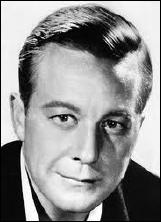
The series returns with only changes in the cast. Gene Raymond might not have been the star like Frank Lovejoy, but he could deliver lines like “When it comes to murder, I’m, just a great big blabbermouth.” Rice’s Malone was still missing. Malone refused to take one client until he was sure the client was innocent, causing Rice’s fans to wonder what the Perry Mason happened to their Malone.
“Devil Finds Work For Idle Hands” (January 29, 1950). A payroll thief (Webb) breaks out of prison to get the girl and loot he left behind. Malone finds the thief’s murdered body in his office, but when Brooks arrives the body is gone.
“Appearances Can Be Deceiving” (February 26, 1950). When a jealous husband kills the man he suspects of cheating with his wife, it sets off a chain of events that has dead bodies falling like dominoes. Webb plays the brother of the murder victim.
â— GEORGE PETRIE. Recorded in New York. Cast: Lt. Sidney Brooks: Larry Haines.
After months off the air, NBC decided to bring back The Amazing Mr. Malone as a summer replacement series starring Edgar G. Robinson (Billboard, February 10, 1951). Something happened and George Petrie was brought in to star instead.
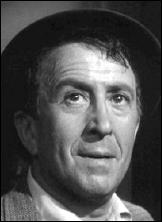
Actually, Petrie was the closest radio got to Rice’s John J. Malone, a coward (“You wouldn’t shoot a guy just because he’s yellow?”), womanizer (he was afraid of guns because they reminded him of weddings), and a fountain of sarcasm. Larry Haines (That Hammer Guy) as Brooks showed a wonderful comedic touch and was the perfect foil for Malone, arguably even better than Rice’s Von Flanagan.
“Strong Defense is the Best Offense” (May 25, 1951). Club owner tries to stop his no good daughter from running off with a gangster. And Malone has to deal with a hitman who named his gun, Marvin.
“Seek And Ye Shall Find” (June 8, 1951). Cheating husband, disappointed when PI finds his wife is not cheating on him, refuses to pay the PI. The PI tries to shake down the wife who goes to Malone. The twists and number of characters leave you feeling like you just watched a Shell game, but Malone finally picks the right killer.
“Early To Bed, Early To Rise” (June 15, 1951). Musician decides to teach his jealous wife a lesson and fakes an affair. It was a fatal mistake.
“Hard Work Never Killed Anyone” (June 22, 1951). A man learns his first wife, thought dead, is alive and married to a rich man. His decision to blackmail her leaves him dead.
“Handsome Is As Handsome Does” (June 29, 1951). Overprotective wife of immature husband tries to save him from a murder rap. One of the weaker episodes, but the character of the femme fatale has some good moments.
“Never Judge a Book By Its Cover” (July 6, 1951). A jealous wife’s PI husband does a LAURA and falls for the woman he is hired to find after seeing her picture. Despite his efforts to protect her from the bad guys looking for her, she ends up murdered. But the killer is a stranger.
“Haste Makes Waste” (July 13, 1951). This final episode has Malone asking the audience to write in and ask for the show’s return to the air.
A complex mystery, not unusual for this series, has a crooked lawyer on the run after he cons a gangster. He had put everything he owned in his wife’s name. Now that he needs the money to get away, she dumps him and keeps the money for herself.
The lawyer hires a classical music loving hitman to kill the gangster. The gangster buys off the hitman. When the lawyer turns up dead, the hitman wants more money and when the gangster refuses, the hitman goes to Malone who represents the wife. Malone, with the help of the hitman, reveals the killer.
My source for all the Frank Lovejoy and George Petrie episodes for free: www.mysteryshows.com; or for purchase: www.originaloldradio.com. The Gene Raymond episodes are available only for purchase at: www.OTRSite.com.
SOURCES: Billboard magazine archives are available for free to view at Google ebookstore.
ADDENDUM:
THE AMAZING MR. MALONE – Australian Version. August 27, 1953 through August 28, 1954. 52 episodes. Grace Gibson Productions. Produced and Directed by Lawrence Cecil or Charles Tingwell. Cast: John Saul as John J. Malone, Harp McGuire as Lt. Brooks.
Grace Gibson Production sold many of the Australian based radio series here in America, mainly in small rural independent radio stations. The production company also purchased some American network series to be recreated by local talent for listeners in Australia. The Amazing Mr. Malone was one of those shows.
Reportedly, the recreations stuck closely to Eugene Wang’s script and the series music. The only noticeable change in content was shifting Malone from Chicago to New York. The style of the stories was more hardboiled than screwball, and the attempts at humor similar to the Gene Raymond era. John Saul’s Malone tended to oversell the humor and some of the hardboiled characters were as over the top as Mugsy in a Bugs Bunny cartoon.
Two of these recreations are still available. I found “Lucky Stiff” for free at Boxcars711 podcast at iTunes. I purchased both episodes from Original Old Radio.
“The Smoothie” (November 5, 1953). Cliche of the week and probable American episode’s title, “Nothing Ventured, Nothing Gained.”
A swindler has his hands full with an upset victim, an unwelcome return of his old partner, and his girlfriend who makes the mistake of trying to help him. He dumps her when he learns she hired John J. Malone. Malone was not all that happy about the job offer either.
“Don’t you want to work?” she asked.
“Does anyone?” replied Malone.
“Lucky Stiff” (November 12, 1953). Cliche of the week and probable American episode’s title, “Lucky In Cards, Unlucky In Love.”
A gambler and mathematical genius has become too successful for anyone to take his bets, so he hires a front. But to make his wife happy he decides to stop gambling and accepts an offer from a publisher to write a book teaching his methods of success at the gaming table. But his luck runs out when he is murdered.
There are many places on the internet to learn more about the people and world of old time Australian radio.
Australianotr.com.au
“Once Upon a Wireless” an oral history with Charles Tingwell.
AUSTRALIAN RADIO SERIES 1930-1970 (available as free pdf at: http://www.dadsotr.com/collectionguide_australianradioseries1930-1970.pdf
« Previous Page — Next Page »




